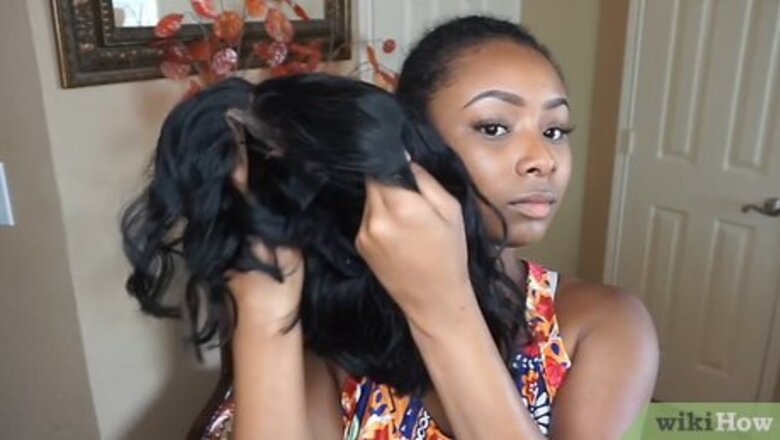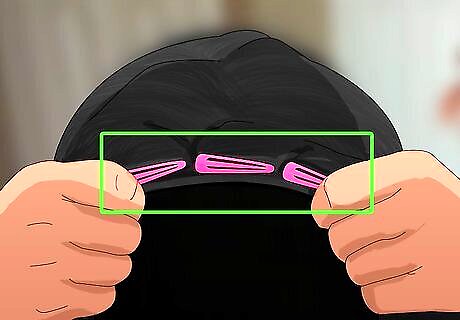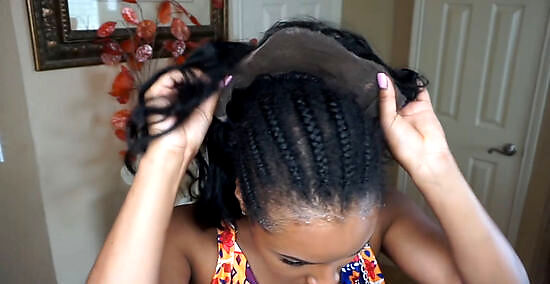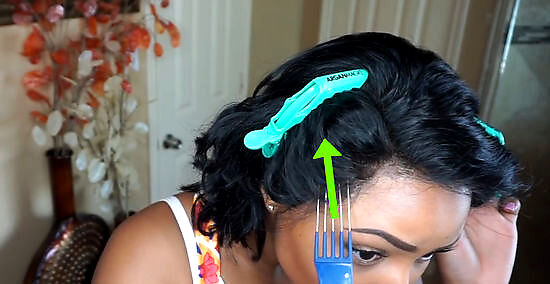
views
Prepping Your Hair and Head

Pick a wig type. There are three major kinds of wigs: the full lace, the partial or front lace, and the non-lace. There are also three main materials they can be made out of, which are human hair, animal hair, and synthetic hair. Each wig type has its pros and cons, so make sure you buy the wig that is best for you. The full lace wig is made with a lace mesh cap and the hair sewn into it throughout. It gives you a natural-looking hairline, is more frequently made with human or animal hair, and is easier to style because it can be parted anywhere. It also allows for more comfort when you are wearing it because it breathes more. The downside is that these wigs can often much more expensive than other types of wigs. These can also get damaged easier because they are not made of more durable fabric. The front or partial lace wig is made with lace mesh at the front instead of all the way around. It gives you a natural-looking hairline on your forehead, but it is made of more durable materials around the main part of your head. These wigs can be made of any of the materials such as human, horse, Brazilian, or synthetic and are cheaper than full lace wigs. The downside is that these wigs are not as natural looking as full lace and can be harder to style because of the way the wig is made. Non-lace wigs are made on materials such as nylon mesh. These wigs can be made with any type of hair material, are more durable, and are much less expensive than other wigs. The downside is that these wigs don't look as realistic as other wigs and don't blend into the hairline as easily as lace wigs.

Prepare your hair. You need to fix your hair so it will not make bumps or uneven places once you have your wig on. Whether you have long or short hair, you need to ensure that all of your natural hair is pulled back from your hairline so it won't be visible under the wig. If your hair is long, you can separate the hair into two pieces and twist them, crossing the two pieces behind your head. Attach them across the top and bottom with bobby pins. If you have long and thick hair, you can do small 1 inch (2.5 cm) twists curls and pin them all around your hair. Grab a 1 inch (2.5 cm) wide portion of your hair and twist it, wrapping the end around your forefinger. Curl the strand down toward your head, making a 1 inch (2.5 cm) wide circle with your hair. Once all the hair is in the curl, pin it with two bobby pins, making an X over the curl. Do this for the entirety of your hair. This will give you a smooth surface on which to apply your wig. Shorter hair can simply be combed and pinned away from the hairline. Try to get your hair as flat against your head as you can. You can also use a stretchy cloth headband or similar item to push your hair away from your hairline.

Prepare your skin. Wipe the skin around your hairline with a cotton pad dipped in an alcohol solution. This removes any access oils and impurities from your skin, which will help the glue or adhesive tape stick better to your skin. Next, apply a scalp protector, which can be a spray, gel, and cream, to the areas around your scalp. This will protect this sensitive skin from irritation and damage from the glue or adhesive tape. Even if you don't have hair and have skipped the previous step, make sure you prepare your skin.

Put on a wig cap. You can use either a net wig cap or a skin-toned nylon wig cap. The net cap breathes a little more while the skin toned cap mimics the color of your scalp under your wig. To apply, gently stretch the cap over your head and line it up perfectly with your hairline, making sure all of your hair is underneath it. Secure it in place with a few bobby pins around the outer edges. Whether you have long or short hair, you need to use a wig cap under your wig. If you don't have any hair, this step is optional. It may prevent some wig slippage but isn't necessary to help smooth out the hair area.

Apply the glue or adhesive tape. For the wig glue, dip a small makeup brush into the glue and apply a thin layer of it around your hairline. Let it dry. This may take a few minutes. You will know it is done when the glue is no longer thin and wet and is instead sticky and tacky. For the adhesive tape, gentle place double-sided strips along your hairline, securing it to your skin. Leave a small space between each strip of tape. This will ensure that moisture can get out when you sweat and it won't compromise an entire section of tape. You don't have to let the tape dry. To ensure that the wig and wig cap doesn't slip, apply the glue or tape slightly on the edge of the cap. This will adhere to the wig, the cap, and your skin together, making it more stable. You can use a combination of these two methods. It is up to you. You don't have to apply glue or tape to your entire scalp line, but make sure you place some at the front of the forehead and on your temples. These are necessary areas for a natural-looking wig. You can then choose any other areas which you think need it and place the adhesives there.
Applying the Wig

Prepare the wig. Before you can apply the wig, you need to make sure the wig hairs won't get caught in the glue or adhesive tape. Make sure you pull all of the wig hair into a ponytail. Or, if the wig hair is short, clip back the hair closest to the edge. If you are working with a full or half lace wig, cut the lace to match your hairline. Make sure you don't cut too much off and disrupt the natural hairline of the wig. Leave a little bit on the edge so it can be glued to your head in a natural-looking way. Don't worry about styling your wig now. It will get messed up during the application process. You will be able to style it after the application.

Place the wig on your head. Hold your finger at the area of the wig that will be at the center of your forehead. Put it over your head and gently lay it down on your scalp, centering your finger on your forehead. After this, gently pull the rest of the wig over your head. Make sure you keep the sides away from the adhesive as much as possible so it doesn't stick before you're ready. Don't bend over and put your wig on upside down. This will give your wig an uncentered look and might stick parts of the hair to the adhesive material before you're ready. If you are putting a wig on for the first time, allow enough time to adjust the wig before you need to leave the house. It may take practice to get it perfect.

Secure the wig. Regardless of the type of adhesive you used, you need to secure the wig to your head. Once you have your wig where you want it, use a fine-toothed comb to gently press down the front edges of the wig. If you're using a lace wig, make sure the lace areas are smooth against your head, making a natural hairline. Once the front half of your wig is secure, wait 15 minutes for it to set. Then follow the same steps as the front on the back portion. Wait 15 more minutes before you style to ensure the wig is secure. You can also use bobby pins to make your wig feel more secure. Place bobby pins through the top of your wig, hooking them into your wig cap and hair underneath. Do this more towards the middle to ensure they aren't visible. Once it's in place, check to see if there is any glue residue visible under the wig. If there is, remove it by gently rubbing the areas with a cotton pad dipped in an alcohol solution. If you don't get the placement of your wig right on the first try, gently run a Q-tip dipped in alcohol solution around the area to detach it from your skin. Re-position your wig and reapply.

Style and accessorize. Once your wig is completely secure, you are free to style your hair as you wish. You can be as fun and adventurous as you want. Wigs can be braided, curled, or accessorized to your heart's content. If you have a synthetic wig, avoid heating the strands because they may melt or get damaged. You can have your wig cut into a style that fits your face before you apply it. This will make the wig feel more like you and appear more natural on your head. Remember that less is always better. Whether your wig is made of human hair, animal hair, or synthetic materials, don't use too much product because it leaves a residue on your wig.




















Comments
0 comment